
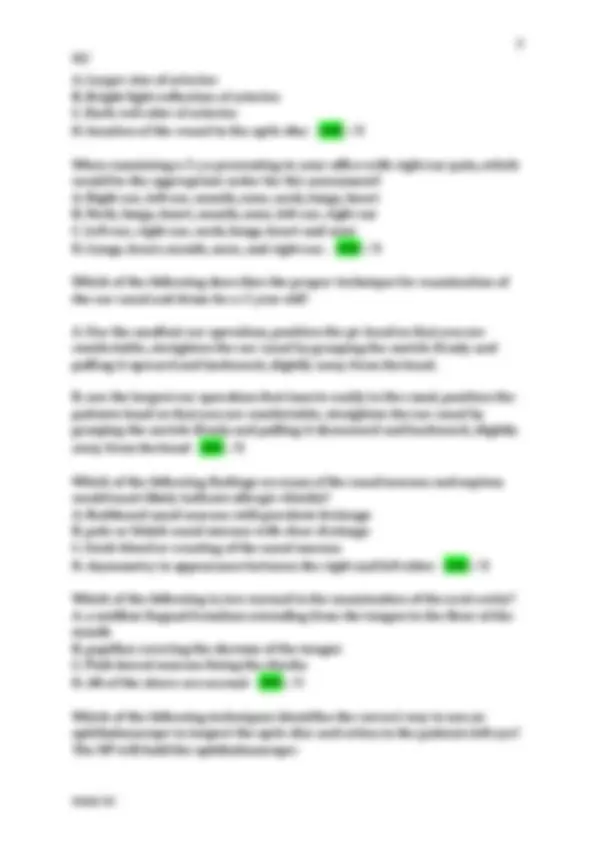
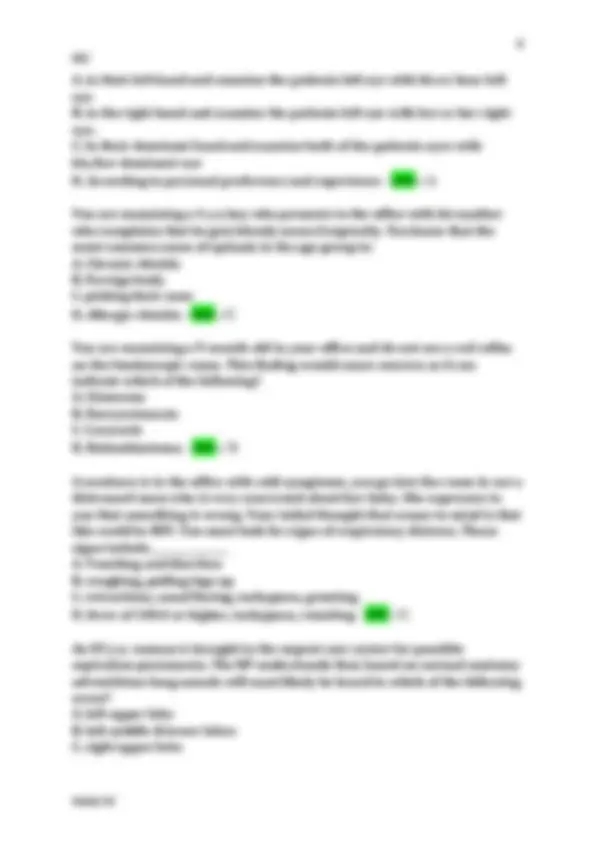
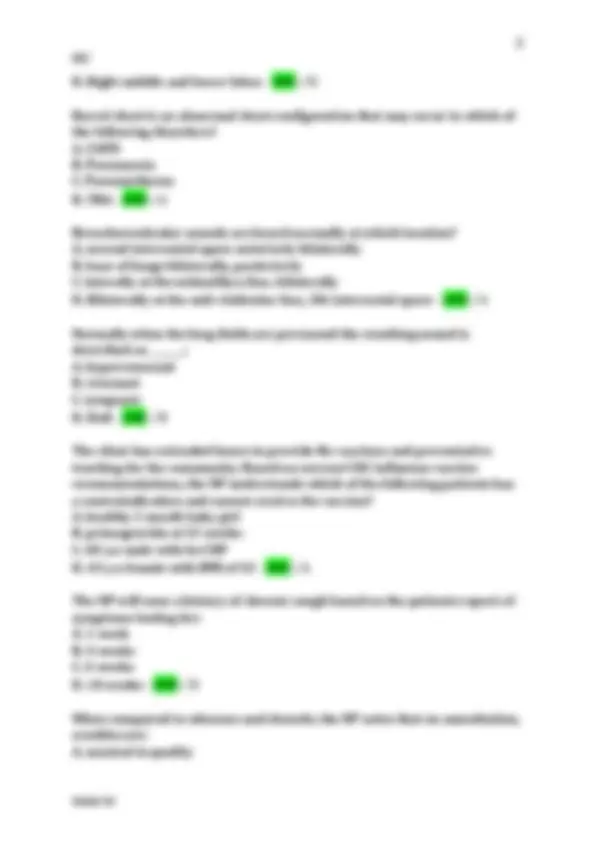
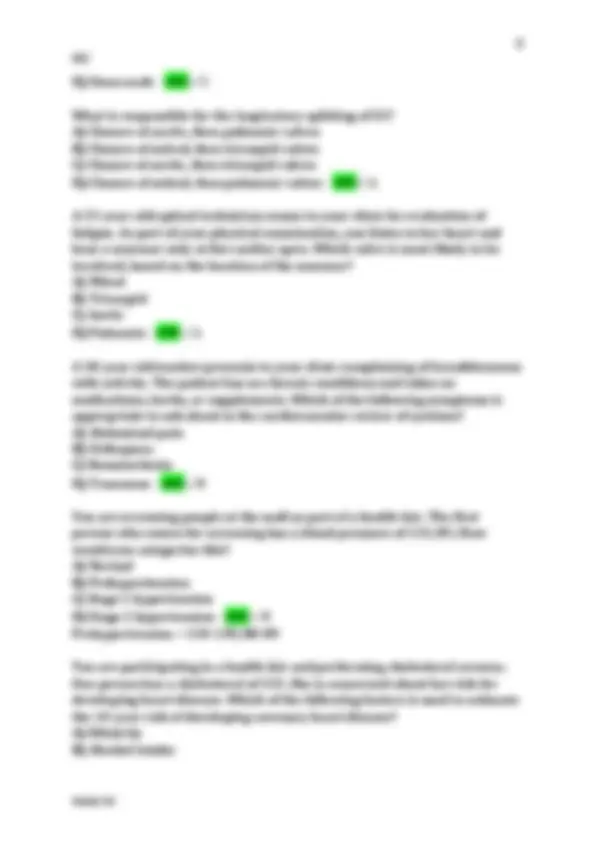
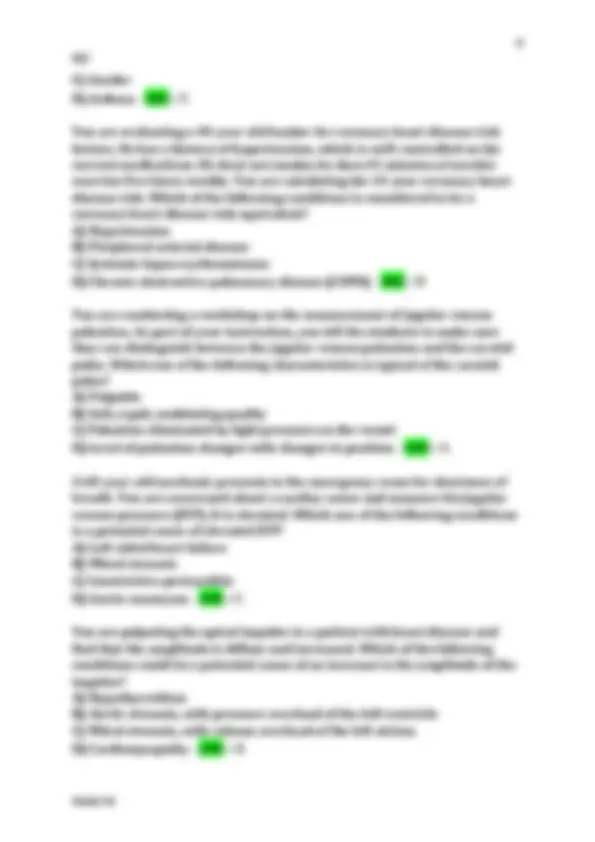
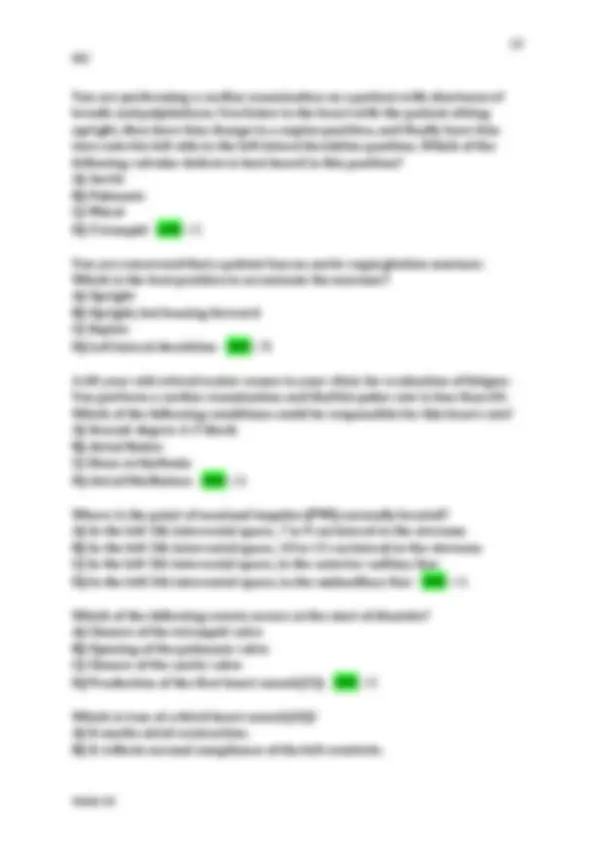
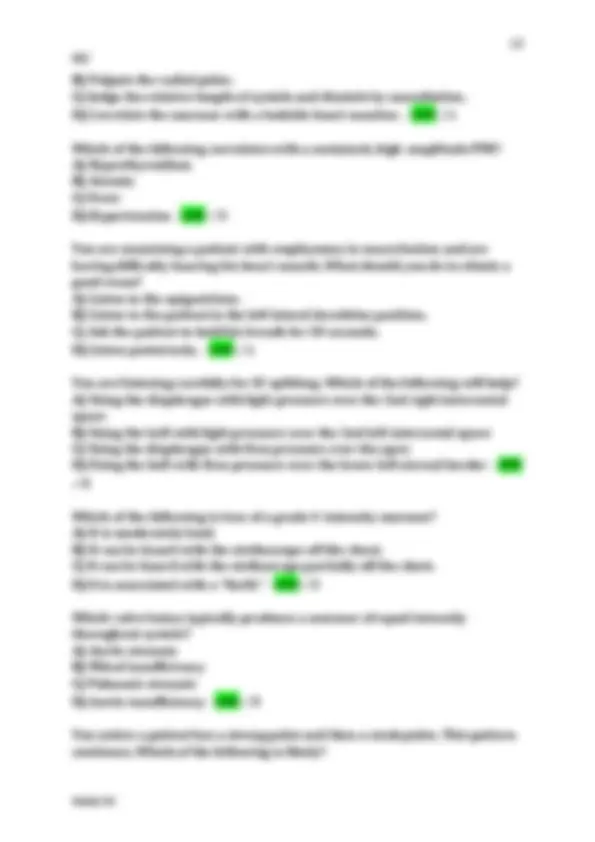
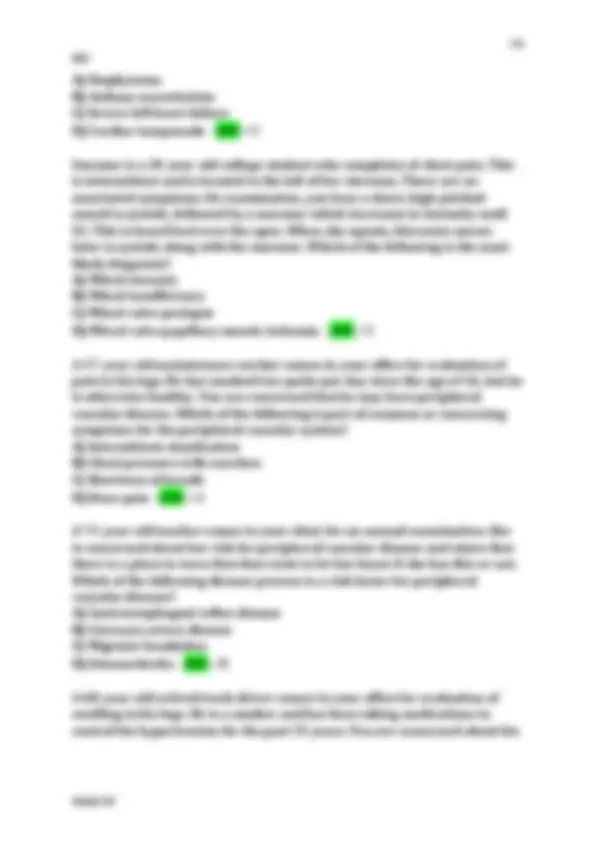
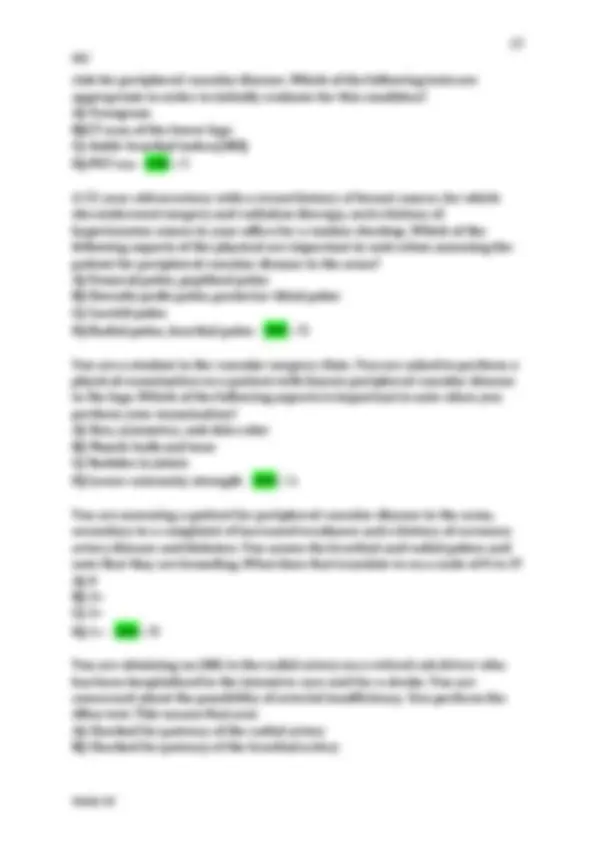
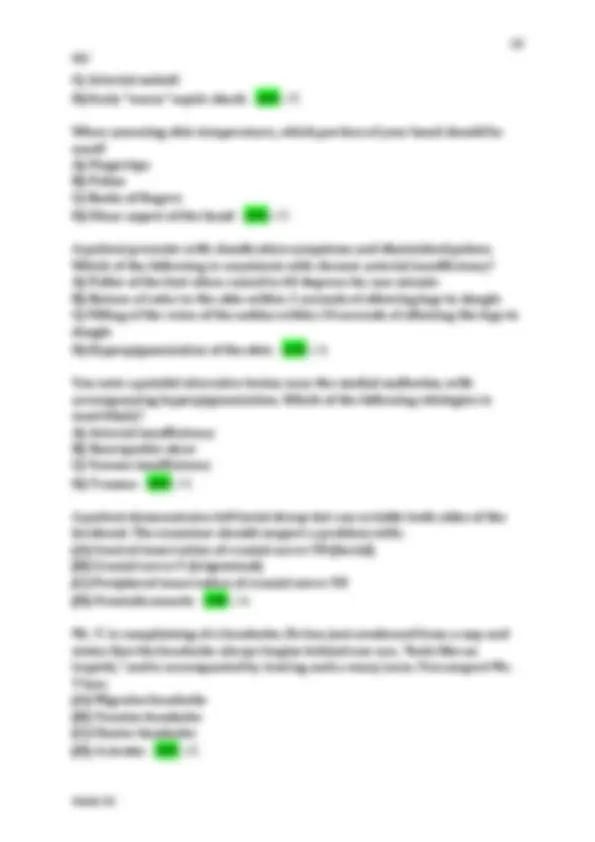
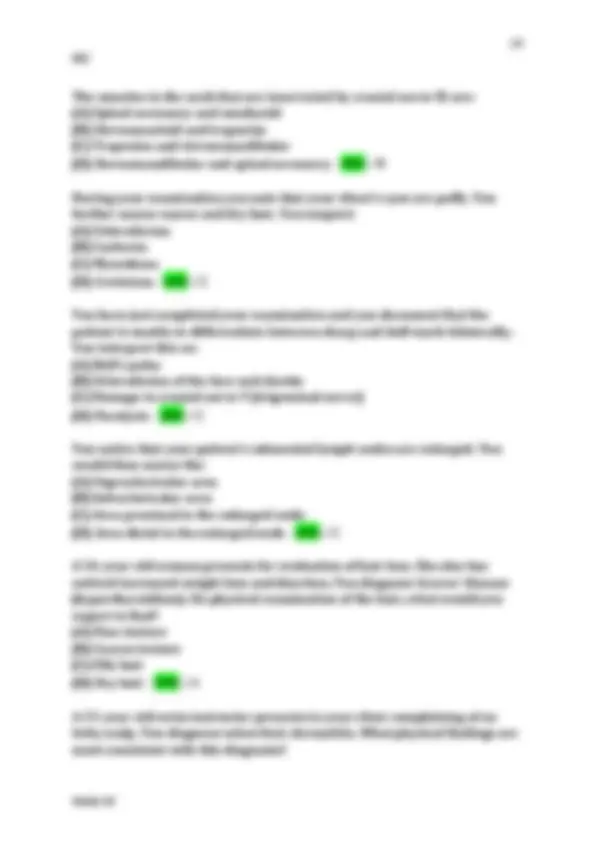
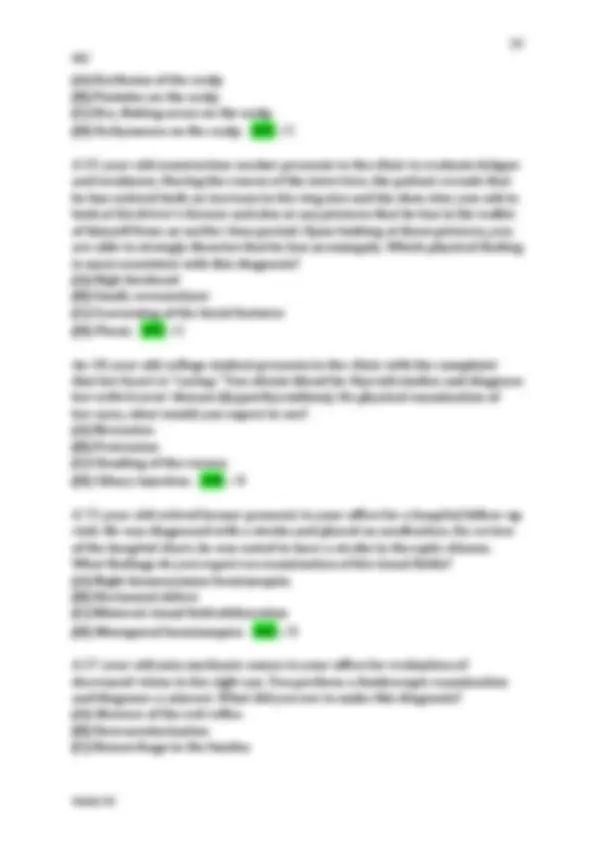
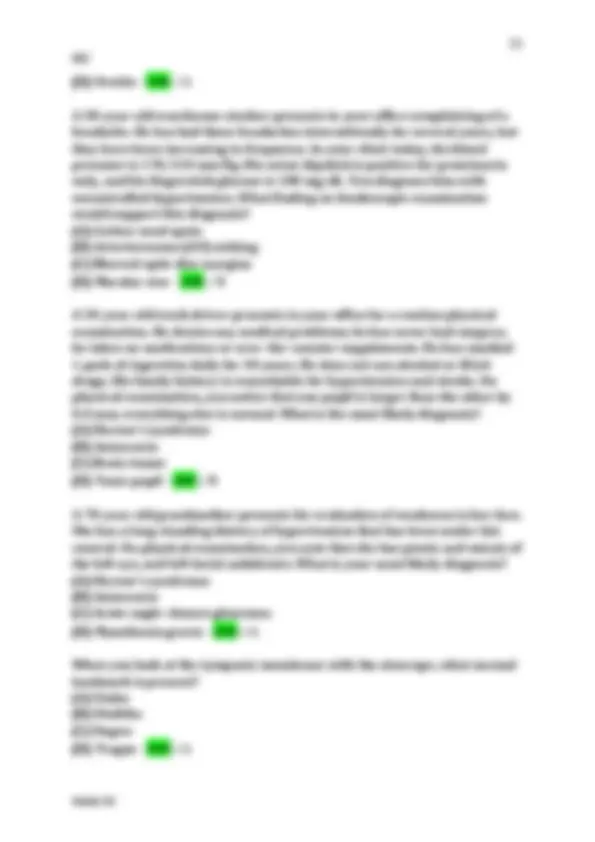
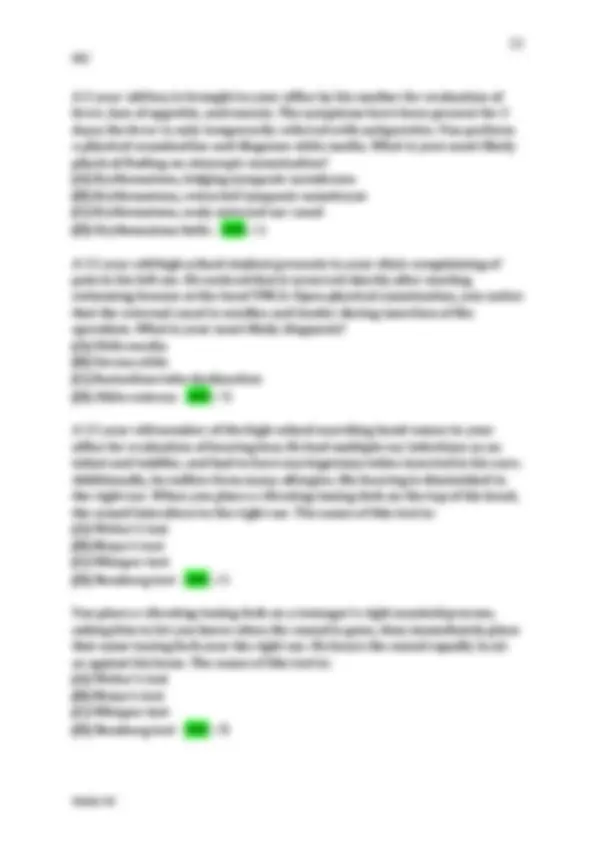
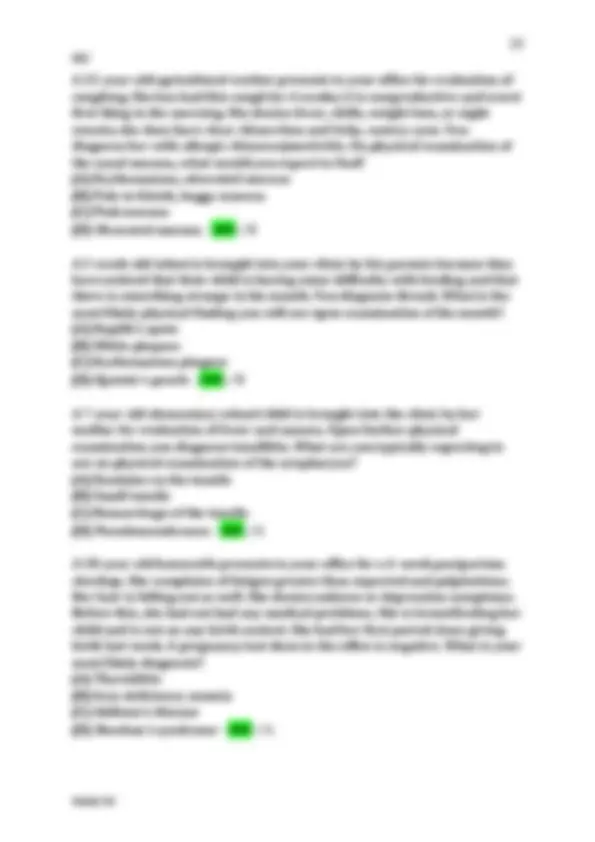
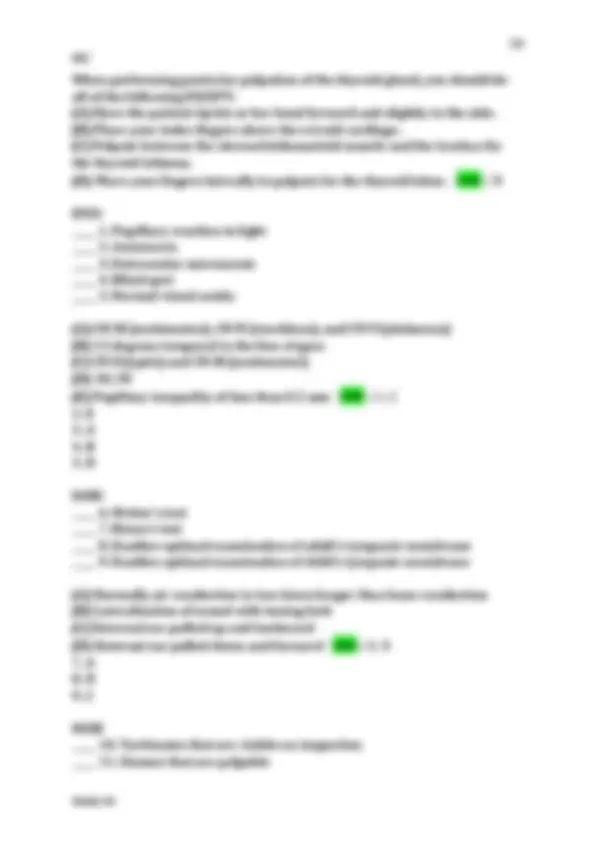
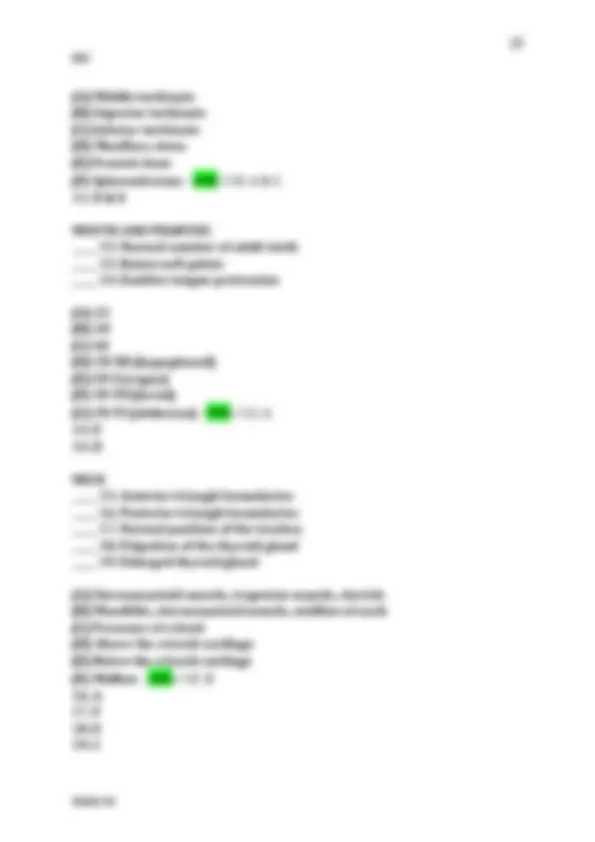
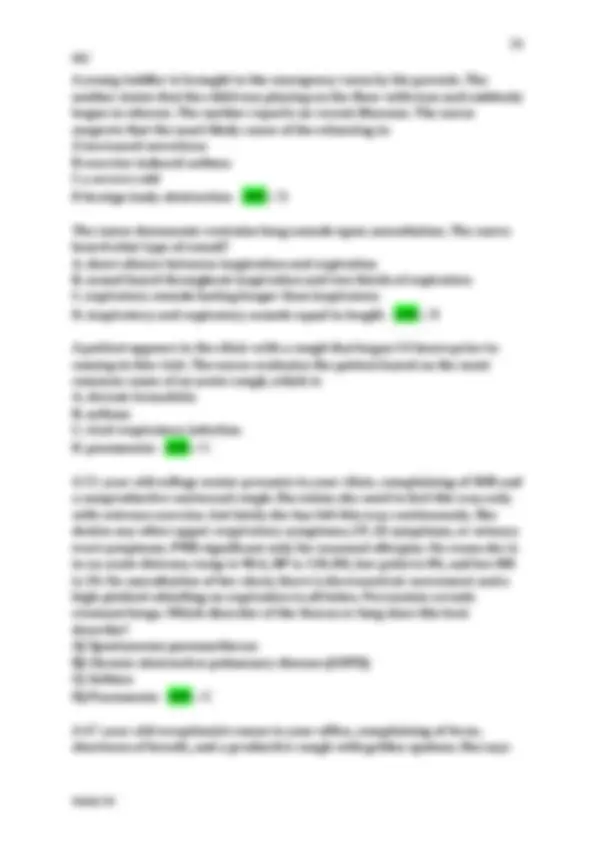
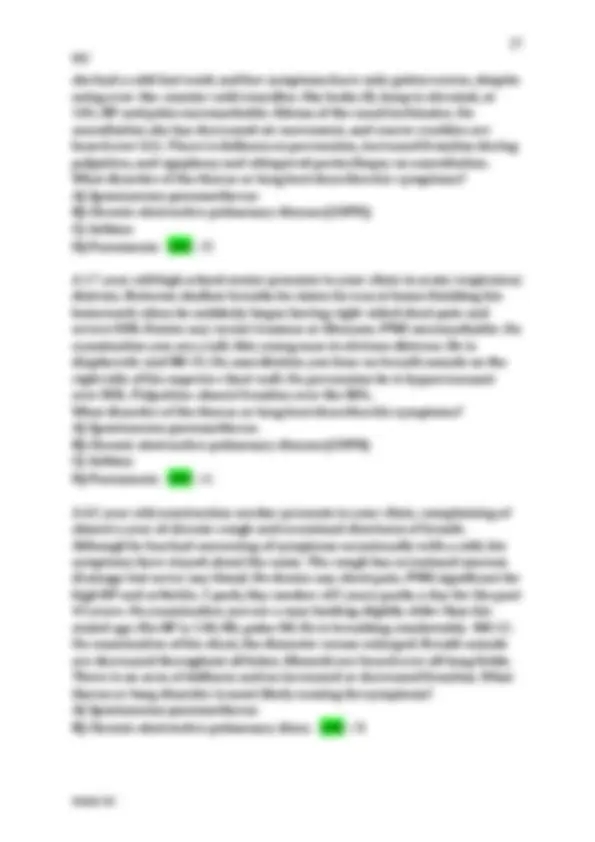
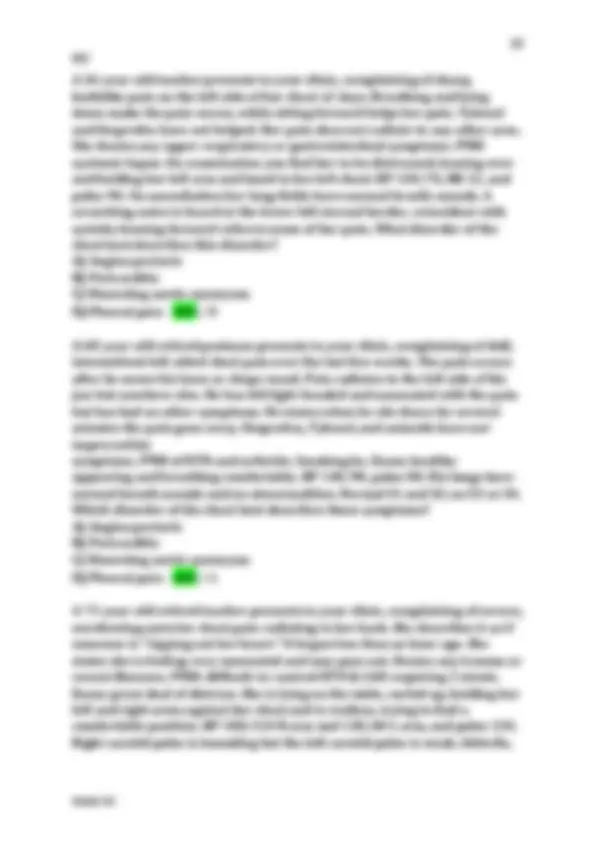
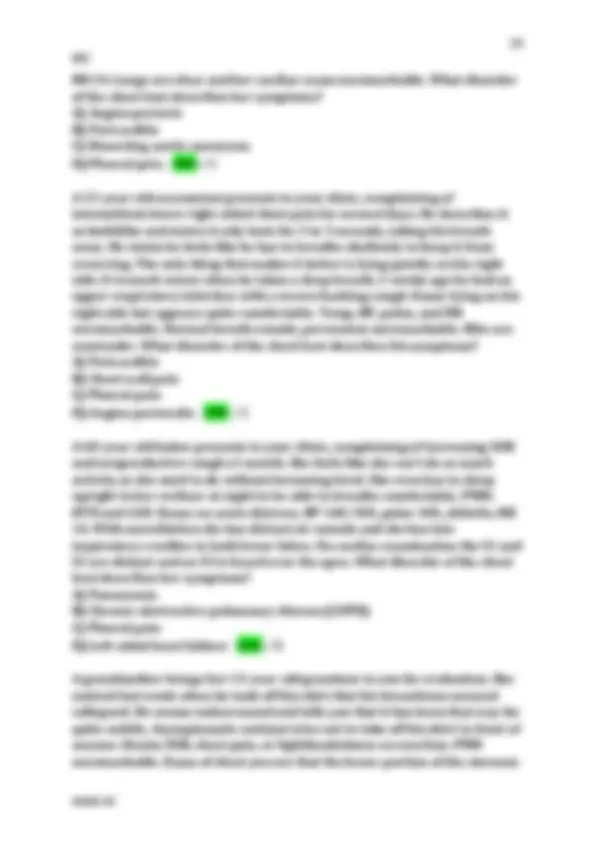
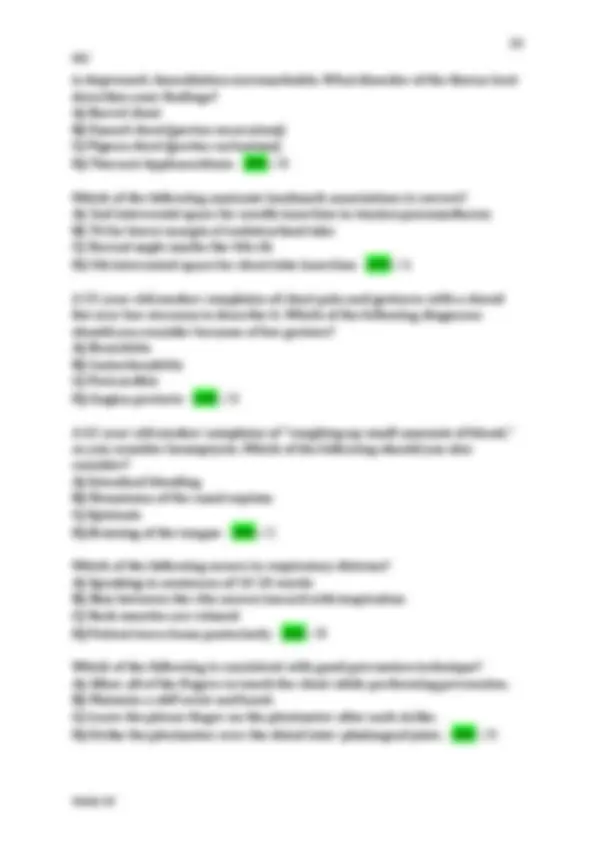
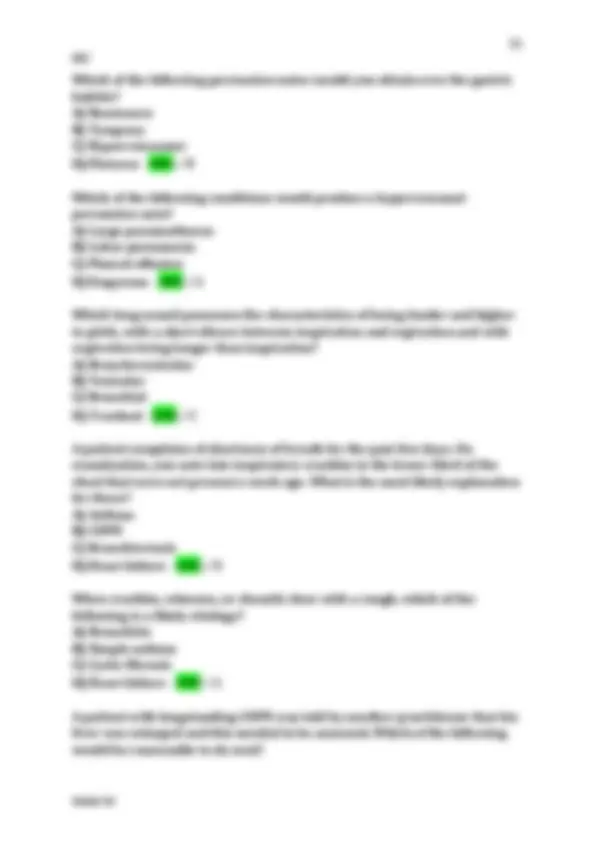
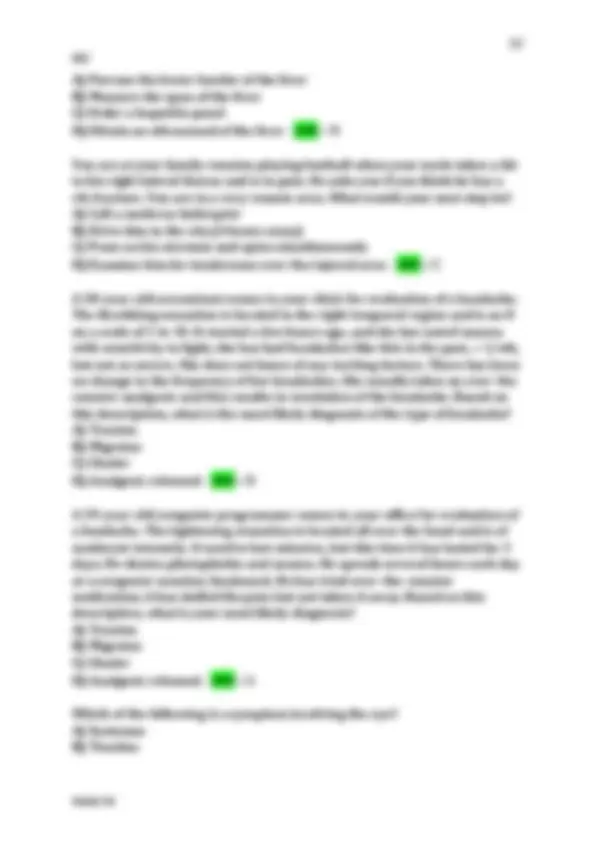
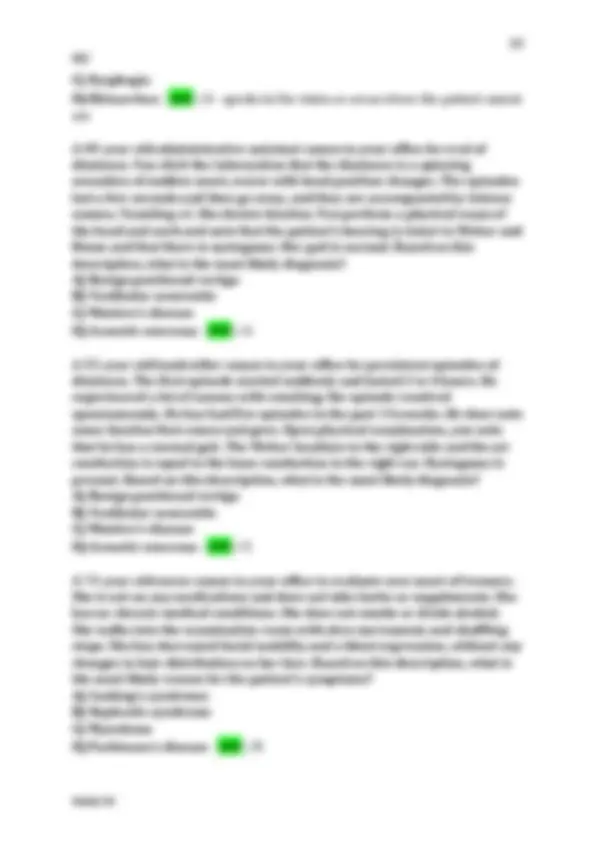
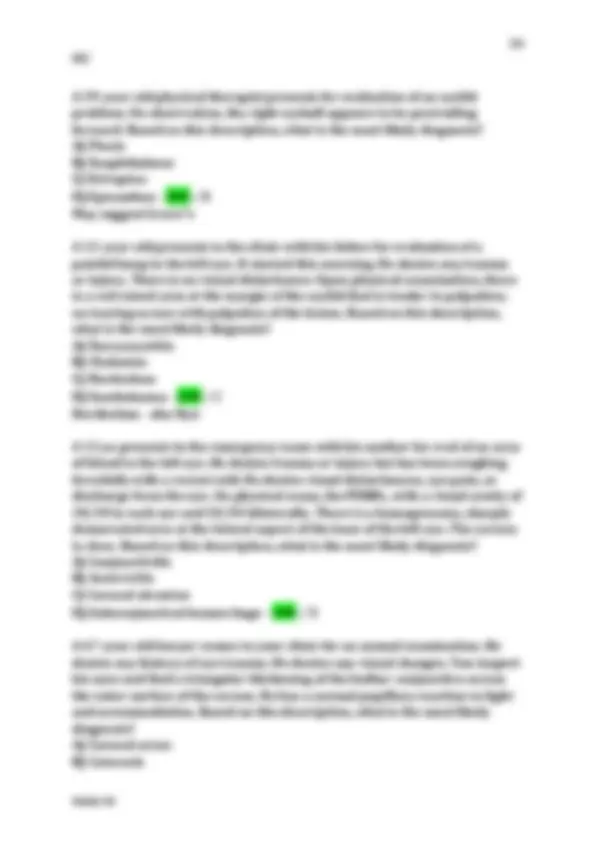
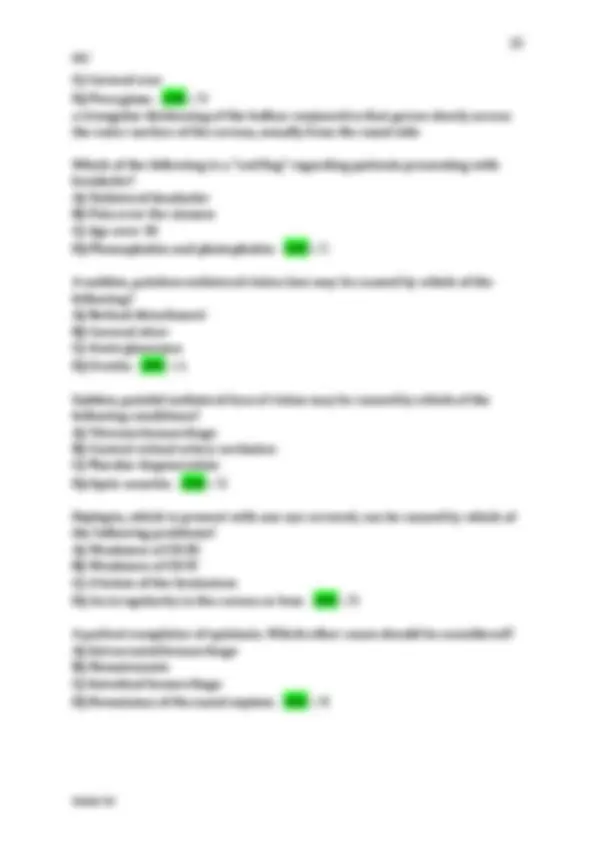
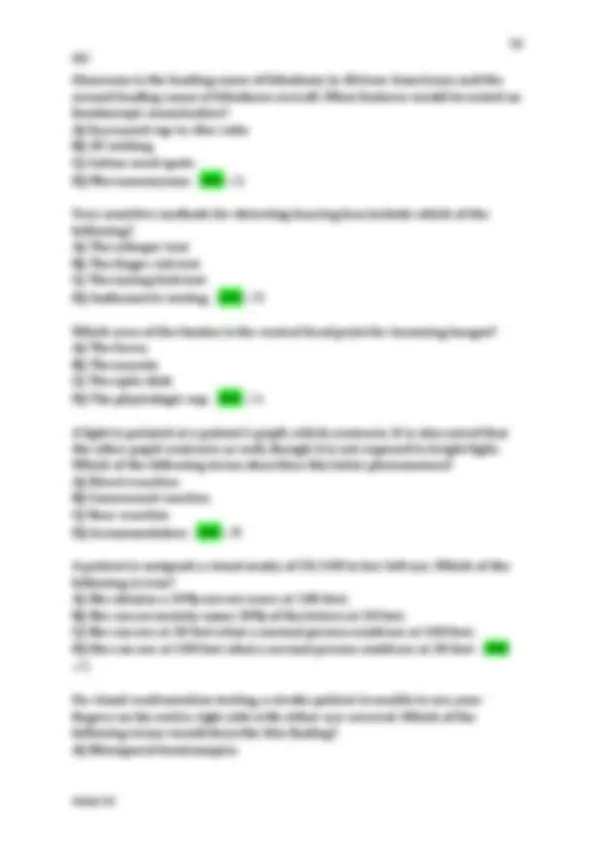
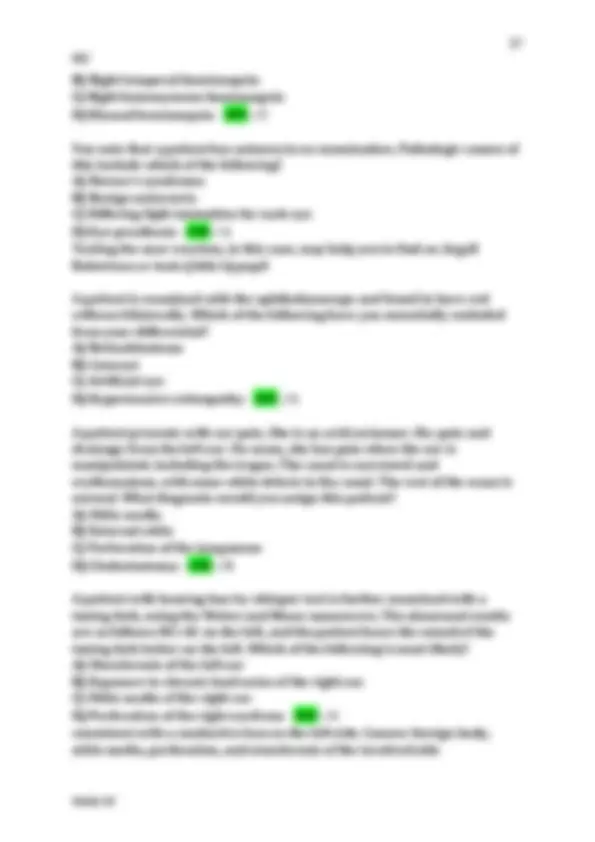
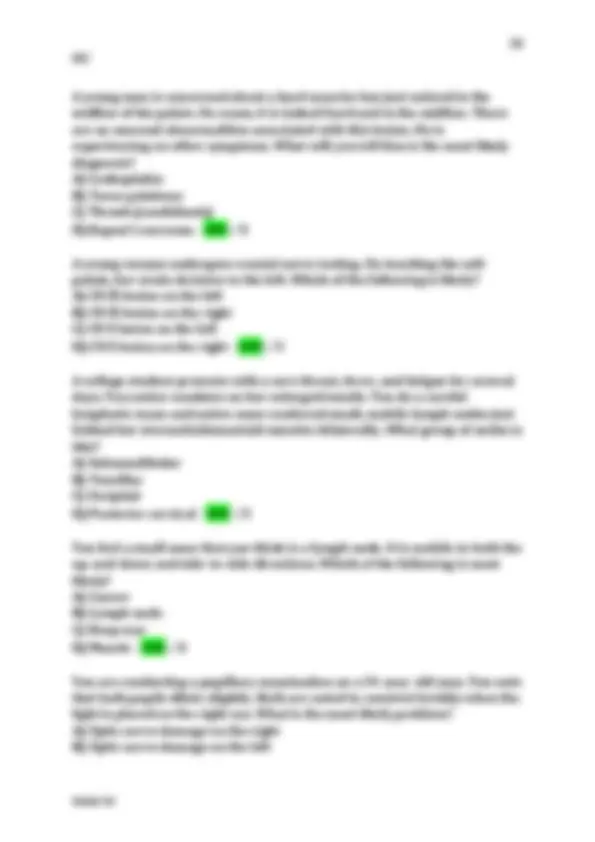
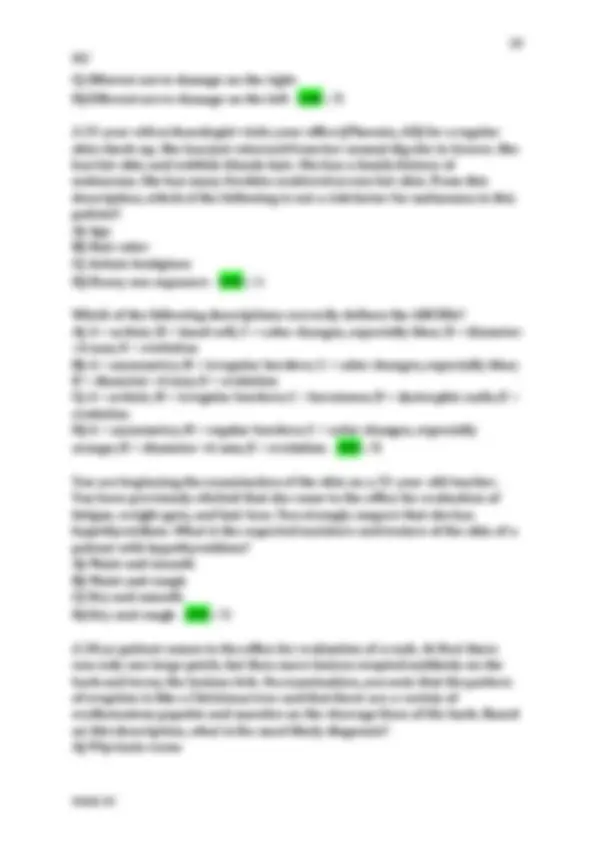
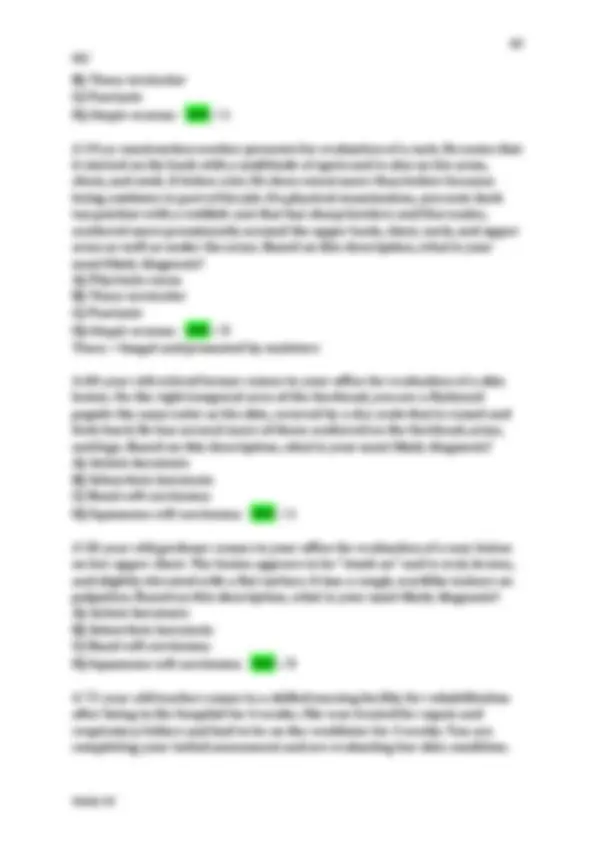
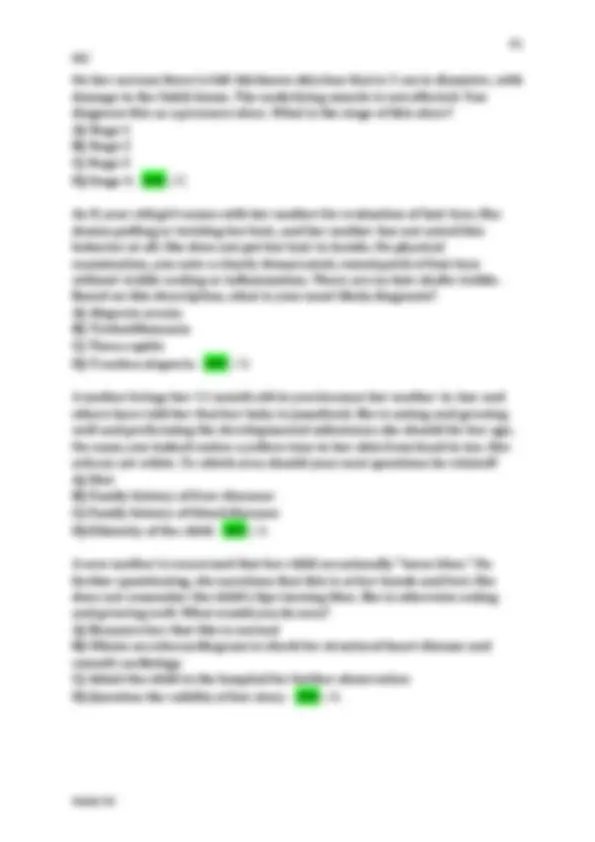
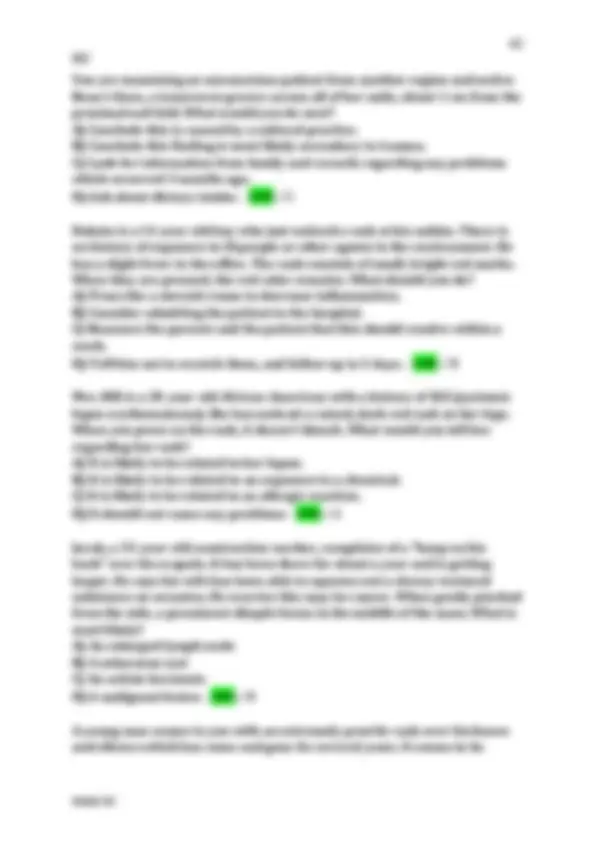
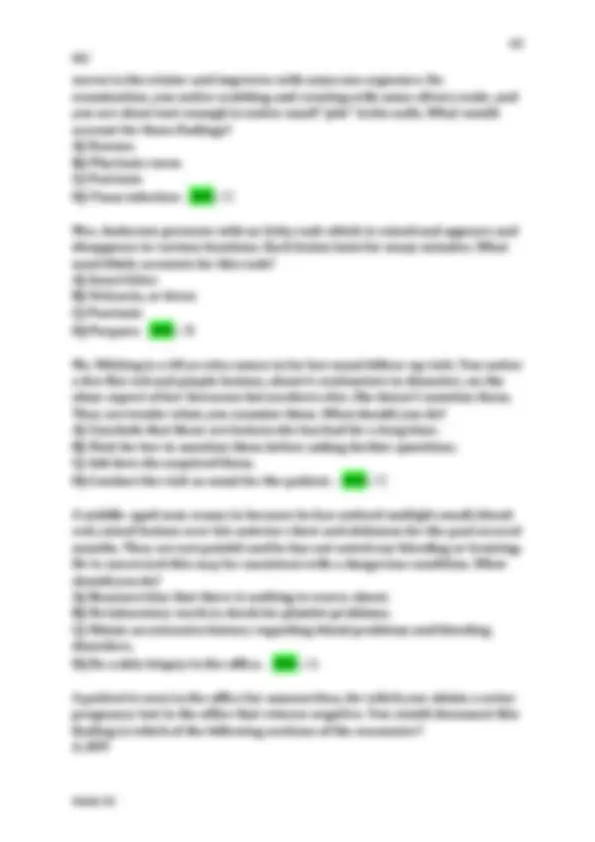
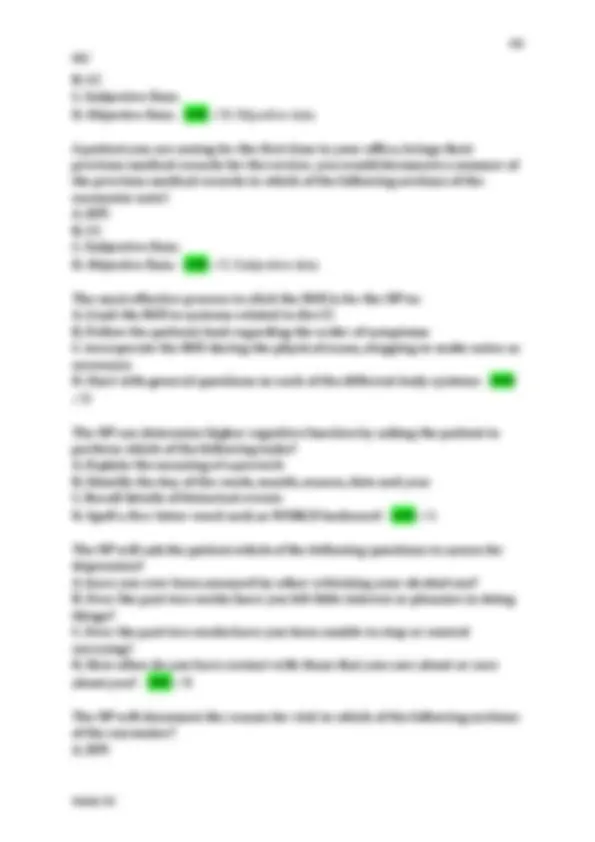
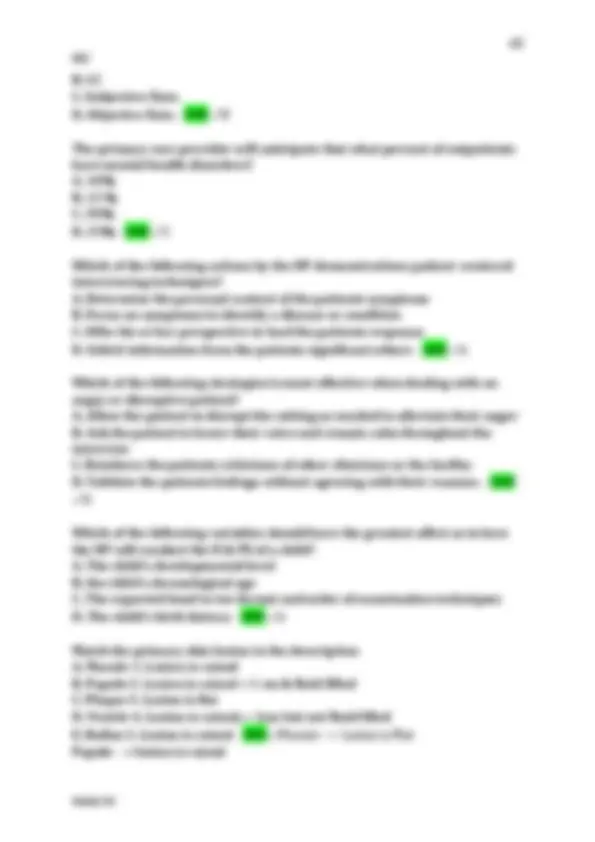
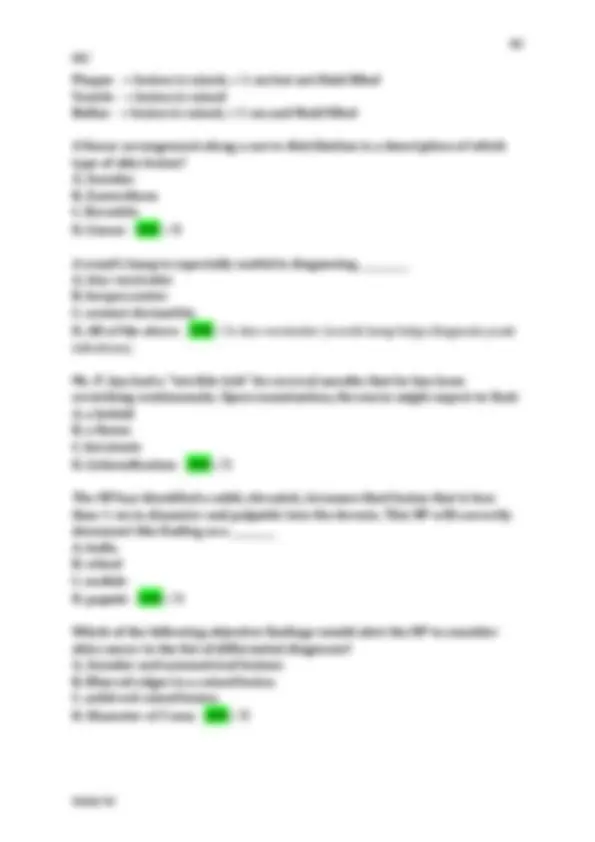
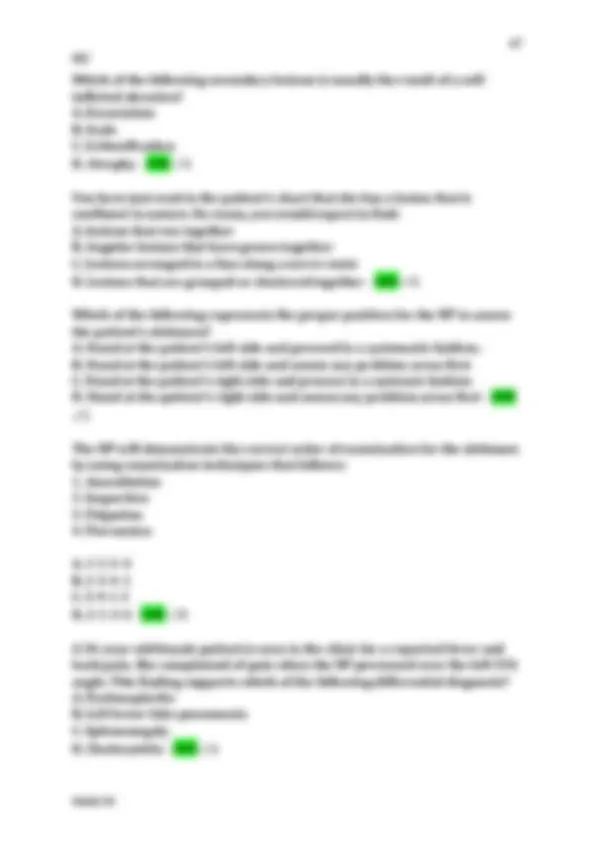
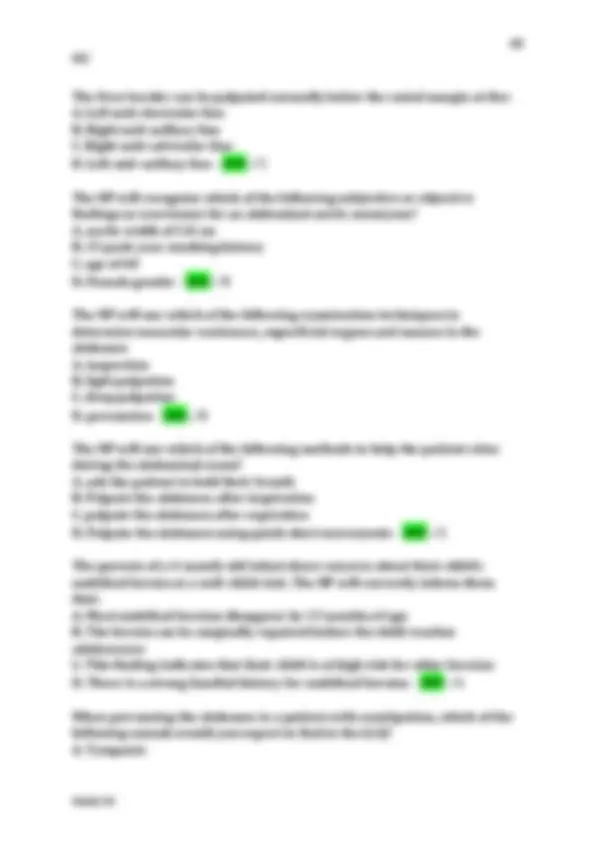



Study with the several resources on Docsity

Earn points by helping other students or get them with a premium plan


Prepare for your exams
Study with the several resources on Docsity

Earn points to download
Earn points by helping other students or get them with a premium plan
Community
Ask the community for help and clear up your study doubts
Discover the best universities in your country according to Docsity users
Free resources
Download our free guides on studying techniques, anxiety management strategies, and thesis advice from Docsity tutors
When percussing the abdomen, you would document the normal finding of percussion over the intestines as: A. Tympanic B. Dull C. Resonant D. Hyperresonant - ANS ✓A Which of the following abdominal exam findings would prompt the NP to consider cholecystitis as a differential diagnosis? A. Positive psoas sign B. Positive Rovsing's sign C. Positive Obturator sign D. Positive murphy's sign - ANS ✓D Which of the following symptoms would you expect from a young adolescent in the early phase of appendicitis? A. Abdominal pain two hours after eating B. CVA tenderness C. Severe RLQ pain with pallor and sweating D. Constipation - ANS ✓C A 40 year old male patient presents with sinus pain, pressure and yellow nasal discharge. Your exam would include palpation of: A. Ethmoid and frontal sinuses B. Maxillary and sphenoid sinuses C. Frontal and maxillary sinuses
Typology: Exams
1 / 49

This page cannot be seen from the preview
Don't miss anything!










































When percussing the abdomen, you would document the normal finding of percussion over the intestines as: A. Tympanic B. Dull C. Resonant D. Hyperresonant - ANS ✓A Which of the following abdominal exam findings would prompt the NP to consider cholecystitis as a differential diagnosis? A. Positive psoas sign B. Positive Rovsing's sign C. Positive Obturator sign D. Positive murphy's sign - ANS ✓D Which of the following symptoms would you expect from a young adolescent in the early phase of appendicitis? A. Abdominal pain two hours after eating B. CVA tenderness C. Severe RLQ pain with pallor and sweating D. Constipation - ANS ✓C A 40 year old male patient presents with sinus pain, pressure and yellow nasal discharge. Your exam would include palpation of: A. Ethmoid and frontal sinuses B. Maxillary and sphenoid sinuses C. Frontal and maxillary sinuses D. Sphenoid and ethmoid sinuses - ANS ✓C A 60 y.o presents with a 3-day history of left eye irritation. Which of the following findings should be recorded in the ROS? A. Patient denies eye pain or change in vision B. Vision is 20/20 by Snellen Chary C. Yellow crust is visible at the inner canthus of the left eye D. all of the above - ANS ✓A
During a physical exam of the throat, which of the following structures of the mouth/throat should rise when the patient says "aah"? A. Hard palate B. Soft palate C. Lingual frenulum D. Buccal mucosa - ANS ✓B In conductive type hearing loss, you would expect: A. sound lateralizes to the good ear when the weber test is used B. sound lateralizes to the affected (bad) ear when the weber test is used C. The weber test remains unaltered with conductive type hearing loss and sound will be heard equally in both ears D. The weber test can cause discomfort in a patient with conductive type hearing loss and should not be used in this situation - ANS ✓B On exam of the posterior pharynx, you are able to visualize the tonsils bilaterally extending just past the anterior and posterior pillars. According to the Friedman Scale, how would you document this finding in your note? A. tonsils noted to be normal B. Tonsils visualized grade 3 C. Tonsils visualized grade 1 D. Tonsils visualized grade 2 - ANS ✓C The NP will assess visual acuity using which of the following tests? A. Snellen test B. Cover test C. Accommodation test D. Confrontation test - ANS ✓A The NP will recognize which of the following findings when assessing the lymph nodes in the head and neck as worrisome, warranting further workup? A. Tender tonsillar and submandibular nodes in the presence of a streptococcal infection B. Any lymph node that the NP is able to roll in two directions: up and down, side to side C. Enlarged supraclavicular nodes D. Deep cervical chain nodes that are inaccessible to exam - ANS ✓C When conducting an ophthalmoscopic exam, the NP will differentiate arteries from veins by noting:
A. in their left hand and examine the patients left eye with his or hear left eye B. in the right hand and examine the patients left eye with her or her right eye. C. In their dominant hand and examine both of the patients eyes with his/her dominant eye D. According to personal preference and experience - ANS ✓A You are examining a 4 y.o boy who presents to the office with his mother who complains that he gets bloody noses frequently. You know that the most common cause of epitaxis in the age group is: A. Chronic rhinitis B. Foreign body C. picking their nose D. Allergic rhinitis - ANS ✓C You are examining a 9-month-old in your office and do not see a red reflex on the fundoscopic exam. This finding would cause concern as it can indicate which of the following? A. Glaucoma B. Dacryostenosis C. Cararacts D. Retinoblastoma - ANS ✓D A newborn is in the office with cold symptoms. you go into the room to see a distressed mom who is very concerned about her baby. She expresses to you that something is wrong. Your initial thought that comes to mind is that this could be RSV. You must look for signs of respiratory distress. Those signs include________________ A. Vomiting and diarrhea B. coughing, pulling legs up C. retractions, nasal flaring, tachypnea, grunting D. fever of 100.4 or higher, tachypnea, vomiting - ANS ✓C An 85 y.o. woman is brought to the urgent care center for possible aspiration pneumonia. The NP understands that, based on normal anatomy adventitious lung sounds will most likely be heard in which of the following areas? A. left upper lobe B. left middle & lower lobes C. right upper lobe
D. Right middle and lower lobes - ANS ✓D Barrel chest is an abnormal chest configuration that may occur in which of the following disorders? A. COPD B. Pneumonia C. Pneumothorax D. TBA - ANS ✓A Bronchovesticular sounds are heard normally at which location? A. second intercostal space anteriorly bilaterally B. base of lungs bilaterally, posteriorly C. laterally at the midaxillary line, bilaterally D. Bilaterally at the mid-clabicular line, 5th intercostal space - ANS ✓A Normally when the lung fields are percussed the resulting sound is described as _______: A. hyperresonant B. resonant C. tympanic D. Dull - ANS ✓B The clinic has extended hours to provide flu vaccines and preventative teaching for the community. Based on current CDC influenza vaccine recommendations, the NP understands which of the following patients has a contraindication and cannot receive the vaccine? A. healthy 2 month baby girl B. primagravida at 32 weeks C. 60 y.o male with hx CHF D. 45 y.o female with BMI of 42 - ANS ✓A The NP will nose a history of chronic cough based on the patients report of symptoms lasting for: A. 1 week B. 4 weeks C. 6 weeks D. 10 weeks - ANS ✓D When compared to wheezes and rhonchi, the NP notes that on auscultation, crackles are: A. musical in quality
a. Avoid unnecessary changes in position b. Maximize patient comfort c. Enhance clinical efficiency d. all of the above - ANS ✓D Chronic pain definition - ANS ✓Pain that persists one month beyond the course of an acute injury Crackles auscultated sound description: - ANS ✓Discontinuous Non-musical Like dots in time Wheezes auscultated sound description: - ANS ✓High pitched with hissing or shrill quality Continuous Rhonchi auscultated sound description: - ANS ✓Continuous Low pitched with snoring quality Vesicular breath sound characteristics: - ANS ✓Inspiration longer than expiration Heard over most lung tissue Tracheal breath sound characteristics: - ANS ✓Inspiration & expiration almost equal Relatively high pitched Intensity of expiration very loud Bronchovesicular breath sound characteristics: - ANS ✓Inspiration and expiration almost equal, and heard in the first and second interspaces anteriorly and between the scapulae Bronchial breath sound characteristics: - ANS ✓Expiration longer than inspiration Heard over large proximal airways You are performing a thorough cardiac examination. Which of the following chambers of the heart can you assess by palpation? A) Left atrium B) Right atrium C) Right ventricle
D) Sinus node - ANS ✓C What is responsible for the inspiratory splitting of S2? A) Closure of aortic, then pulmonic valves B) Closure of mitral, then tricuspid valves C) Closure of aortic, then tricuspid valves D) Closure of mitral, then pulmonic valves - ANS ✓A A 25-year-old optical technician comes to your clinic for evaluation of fatigue. As part of your physical examination, you listen to her heart and hear a murmur only at the cardiac apex. Which valve is most likely to be involved, based on the location of the murmur? A) Mitral B) Tricuspid C) Aortic D) Pulmonic - ANS ✓A A 58-year-old teacher presents to your clinic complaining of breathlessness with activity. The patient has no chronic conditions and takes no medications, herbs, or supplements. Which of the following symptoms is appropriate to ask about in the cardiovascular review of systems? A) Abdominal pain B) Orthopnea C) Hematochezia D) Tenesmus - ANS ✓B You are screening people at the mall as part of a health fair. The first person who comes for screening has a blood pressure of 132/85. How would you categorize this? A) Normal B) Prehypertension C) Stage 1 hypertension D) Stage 2 hypertension - ANS ✓B Prehypertension = 120-139/80- 89 You are participating in a health fair and performing cholesterol screens. One person has a cholesterol of 225. She is concerned about her risk for developing heart disease. Which of the following factors is used to estimate the 10-year risk of developing coronary heart disease? A) Ethnicity B) Alcohol intake
You are performing a cardiac examination on a patient with shortness of breath and palpitations. You listen to the heart with the patient sitting upright, then have him change to a supine position, and finally have him turn onto his left side in the left lateral decubitus position. Which of the following valvular defects is best heard in this position? A) Aortic B) Pulmonic C) Mitral D) Tricuspid - ANS ✓C You are concerned that a patient has an aortic regurgitation murmur. Which is the best position to accentuate the murmur? A) Upright B) Upright, but leaning forward C) Supine D) Left lateral decubitus - ANS ✓B A 68-year-old retired waiter comes to your clinic for evaluation of fatigue. You perform a cardiac examination and find his pulse rate is less than 60. Which of the following conditions could be responsible for this heart rate? A) Second-degree A-V block B) Atrial flutter C) Sinus arrhythmia D) Atrial fibrillation - ANS ✓A Where is the point of maximal impulse (PMI) normally located? A) In the left 5th intercostal space, 7 to 9 cm lateral to the sternum B) In the left 5th intercostal space, 10 to 12 cm lateral to the sternum C) In the left 5th intercostal space, in the anterior axillary line D) In the left 5th intercostal space, in the midaxillary line - ANS ✓A Which of the following events occurs at the start of diastole? A) Closure of the tricuspid valve B) Opening of the pulmonic valve C) Closure of the aortic valve D) Production of the first heart sound (S1) - ANS ✓C Which is true of a third heart sound (S3)? A) It marks atrial contraction. B) It reflects normal compliance of the left ventricle.
C) It is caused by rapid deceleration of blood against the ventricular wall. D) It is not heard in atrial fibrillation. - ANS ✓C Which is true of splitting of the second heart sound? A) It is best heard over the pulmonic area with the bell of the stethoscope. B) It normally increases with exhalation. C) It is best heard over the apex. D) It does not vary with respiration. - ANS ✓A Which of the following is true of jugular venous pressure (JVP) measurement? A) It is measured with the patient at a 45-degree angle. B) The vertical height of the blood column in centimeters, plus 5 cm, is the JVP. C) A JVP below 9 cm is abnormal. D) It is measured above the sternal notch. - ANS ✓B Which of the following regarding jugular venous pulsations is a systolic phenomenon? A) The "y" descent B) The "x" descent C) The upstroke of the "a" wave D) The downstroke of the "v" wave - ANS ✓B How much does cardiovascular risk increase for each increment of 20 mm Hg systolic and 10 mm Hg diastolic in blood pressure? A) 25% B) 50% C) 75% D) 100% - ANS ✓D In healthy adults over 20, how often should blood pressure, body mass index, waist circumference, and pulse be assessed, according to American Heart Association guidelines? A) Every 6 months B) Every year C) Every 2 years D) Every 5 years - ANS ✓C Which of the following is a clinical identifier of metabolic syndrome? A) Waist circumference of 38 inches for a male
B) Palpate the radial pulse. C) Judge the relative length of systole and diastole by auscultation. D) Correlate the murmur with a bedside heart monitor. - ANS ✓A Which of the following correlates with a sustained, high-amplitude PMI? A) Hyperthyroidism B) Anemia C) Fever D) Hypertension - ANS ✓D You are examining a patient with emphysema in exacerbation and are having difficulty hearing his heart sounds. What should you do to obtain a good exam? A) Listen in the epigastrium. B) Listen to the patient in the left lateral decubitus position. C) Ask the patient to hold his breath for 30 seconds. D) Listen posteriorly. - ANS ✓A You are listening carefully for S2 splitting. Which of the following will help? A) Using the diaphragm with light pressure over the 2nd right intercostal space B) Using the bell with light pressure over the 2nd left intercostal space C) Using the diaphragm with firm pressure over the apex D) Using the bell with firm pressure over the lower left sternal border - ANS ✓B Which of the following is true of a grade 4-intensity murmur? A) It is moderately loud. B) It can be heard with the stethoscope off the chest. C) It can be heard with the stethoscope partially off the chest. D) It is associated with a "thrill." - ANS ✓D Which valve lesion typically produces a murmur of equal intensity throughout systole? A) Aortic stenosis B) Mitral insufficiency C) Pulmonic stenosis D) Aortic insufficiency - ANS ✓B You notice a patient has a strong pulse and then a weak pulse. This pattern continues. Which of the following is likely?
A) Emphysema B) Asthma exacerbation C) Severe left heart failure D) Cardiac tamponade - ANS ✓C Suzanne is a 20-year-old college student who complains of chest pain. This is intermittent and is located to the left of her sternum. There are no associated symptoms. On examination, you hear a short, high-pitched sound in systole, followed by a murmur which increases in intensity until S2. This is heard best over the apex. When she squats, this noise moves later in systole along with the murmur. Which of the following is the most likely diagnosis? A) Mitral stenosis B) Mitral insufficiency C) Mitral valve prolapse D) Mitral valve papillary muscle ischemia - ANS ✓C A 57-year-old maintenance worker comes to your office for evaluation of pain in his legs. He has smoked two packs per day since the age of 16, but he is otherwise healthy. You are concerned that he may have peripheral vascular disease. Which of the following is part of common or concerning symptoms for the peripheral vascular system? A) Intermittent claudication B) Chest pressure with exertion C) Shortness of breath D) Knee pain - ANS ✓A A 72-year-old teacher comes to your clinic for an annual examination. She is concerned about her risk for peripheral vascular disease and states that there is a place in town that does tests to let her know if she has this or not. Which of the following disease process is a risk factor for peripheral vascular disease? A) Gastroesophageal reflux disease B) Coronary artery disease C) Migraine headaches D) Osteoarthritis - ANS ✓B A 68-year-old retired truck driver comes to your office for evaluation of swelling in his legs. He is a smoker and has been taking medications to control his hypertension for the past 25 years. You are concerned about his
C) Checked for patency of the ulnar artery D) Checked for patency of the femoral artery - ANS ✓C You are assessing a 59-year-old gas station owner for atherosclerosis in the lower extremities. In which of the following locations would the patient's pain make you concerned for this disease process? A) Thigh B) Knee C) Calf D) Ankle - ANS ✓C You are performing a routine check-up on an 81-year-old retired cotton farmer in the vascular surgery clinic. You note that he has a history of chronic arterial insufficiency. Which of the following physical examination findings in the lower extremities would be expected with this disease? A) Normal pulsation B) Normal temperature C) Marked edema D) Thin, shiny, atrophic Skin - ANS ✓D A 77-year-old retired nurse has an ulcer on a lower extremity that you are asked to evaluate when you do your weekly rounds at a local long-term care facility. All of the following are responsible for causing ulcers in the lower extremities except for which condition? A) Arterial insufficiency B) Venous insufficiency C) Diminished sensation in pressure points D) Hypertension - ANS ✓D As the internal diameter of a blood vessel changes, the resistance also changes. Which of the following descriptions depicts this relationship? A) Resistance varies linearly with the diameter. B) Resistance varies proportionally to the second power of the diameter. C) Resistance varies proportionally to the third power of the diameter. D) Resistance varies proportionally to the fourth power of the diameter. - ANS ✓D Which area of the arm drains to the epitrochlear nodes? A) Ulnar surface of the forearm and hand, little and ring fingers, and ulnar middle finger
B) Radial surface of the forearm and hand, thumb and index fingers, and radial middle finger C) Ulnar surface of the forearm and hand; second, third, and fourth fingers D) Radial surface of the forearm and hand; second, third, and fourth fingers
The muscles in the neck that are innervated by cranial nerve XI are: (A) Spinal accessory and omohyoid (B) Sternomastoid and trapezius (C) Trapezius and sternomandibular (D) Sternomandibular and spinal accessory - ANS ✓B During your examination you note that your client's eyes are puffy. You further assess coarse and dry hair. You suspect: (A) Scleroderma (B) Cachexia (C) Myxedema (D) Cretinism - ANS ✓C You have just completed your examination and you document that the patient is unable to differentiate between sharp and dull touch bilaterally. You interpret this as: (A) Bell's palsy (B) Scleroderma of the face and cheeks (C) Damage to cranial nerve V (trigeminal nerve) (D) Paralysis - ANS ✓C You notice that your patient's submental lymph nodes are enlarged. You would then assess the: (A) Supraclavicular area (B) Infraclavicular area (C) Area proximal to the enlarged node (D) Area distal to the enlarged node - ANS ✓C A 26-year-old woman presents for evaluation of hair loss. She also has noticed increased weight loss and diarrhea. You diagnose Graves' disease (hyperthyroidism). On physical examination of the hair, what would you expect to find? (A) Fine texture (B) Coarse texture (C) Oily hair (D) Dry hair - ANS ✓A A 25-year-old swim instructor presents to your clinic complaining of an itchy scalp. You diagnose seborrheic dermatitis. What physical findings are most consistent with this diagnosis?
(A) Erythema of the scalp (B) Pustules on the scalp (C) Dry, flaking areas on the scalp (D) Ecchymoses on the scalp - ANS ✓C A 55-year-old construction worker presents to the clinic to evaluate fatigue and weakness. During the course of the interview, the patient reveals that he has noticed both an increase in his ring size and his shoe size; you ask to look at his driver's license and also at any pictures that he has in his wallet of himself from an earlier time period. Upon looking at these pictures, you are able to strongly theorize that he has acromegaly. Which physical finding is most consistent with this diagnosis? (A) High forehead (B) Small, recessed jaw (C) Coarsening of the facial features (D) Ptosis - ANS ✓C An 18-year-old college student presents to the clinic with the complaint that her heart is "racing." You obtain blood for thyroid studies and diagnose her with Graves' disease (hyperthyroidism). On physical examination of her eyes, what would you expect to see? (A) Recession (B) Protrusion (C) Clouding of the cornea (D) Ciliary injection - ANS ✓B A 75-year-old retired farmer presents to your office for a hospital follow-up visit. He was diagnosed with a stroke and placed on medication. On review of the hospital chart, he was noted to have a stroke in the optic chiasm. What findings do you expect on examination of his visual fields? (A) Right homonymous hemianopsia (B) Horizontal defect (C) Bilateral visual field obliteration (D) Bitemporal hemianopsia - ANS ✓D A 57-year-old auto mechanic comes to your office for evaluation of decreased vision in his right eye. You perform a fundoscopic examination and diagnose a cataract. What did you see to make this diagnosis? (A) Absence of the red reflex (B) Neovascularization (C) Hemorrhage in the fundus